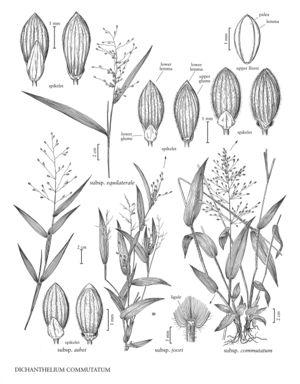Difference between revisions of "Dichanthelium commutatum subsp. commutatum"
Synonyms: Panicum commutatum var. joorii unknown Panicum mutabile unknown
Treatment appears in FNA Volume 25. Treatment on page 414.
FNA>Volume Importer |
FNA>Volume Importer |
||
| Line 41: | Line 41: | ||
|publication year= | |publication year= | ||
|special status= | |special status= | ||
| − | |source xml=https://jpend@bitbucket.org/aafc-mbb/fna-data-curation.git/src/ | + | |source xml=https://jpend@bitbucket.org/aafc-mbb/fna-data-curation.git/src/f6b125a955440c0872999024f038d74684f65921/coarse_grained_fna_xml/V25/V25_1140.xml |
|subfamily=Poaceae subfam. Panicoideae | |subfamily=Poaceae subfam. Panicoideae | ||
|tribe=Poaceae tribe Paniceae | |tribe=Poaceae tribe Paniceae | ||
Revision as of 19:21, 24 September 2019
Plants with caudices. Culms more or less erect, usually glabrous, sometimes sparsely pubescent or puberulent. Basal blades large, usually 8-14 cm long, 7-22 mm wide. Cauline blades 3.5-8 times as long as wide, 6-25 mm wide, thin, ovate-lanceolate, green, sometimes glaucous, bases almost symmetrical. Spikelets 2.6-2.9 mm. Lower glumes about 1/4 as long as the spikelets; lower lemmas rounded apically.
Discussion
Dichanthelium commutatum subsp. commutatum grows in wet to dry woodlands. Its range extends to South America.
Selected References
None.
Lower Taxa
None.
... more about "Dichanthelium commutatum subsp. commutatum"
